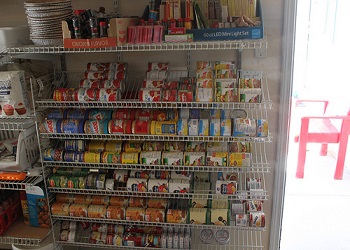It was only since the middle of the last century that stockpiling became so popular, thanks in part to the popularity of ‘extreme coupons’. Indeed, one look at the TV show highlighting the crazy coupon adventures and you know for sure: super saves are back in a big way.
But if you really examine the philosophy behind optimized buying, multiple item buying, and the resulting shelf arrangement, you see how the trend is so much more than just a flash in the pan.
Here’s a closer look at why some people even find this type of massive storage a thing of beauty.
Basic Benefits of Stocking Up
Besides having your own shopping mall in your closet or basement (which is pretty cool on its own!), there are practical benefits to buying and storing excess quantities of produce and merchandise. For example:
- Buying additional items (which you will eventually buy) when they are offered at a discounted price is a great way to save money at check-out.
- Saving extra helps you stay on track when you plan meals in advance (it’s also a guaranteed way to stretch your budget and minimize the stretch on your belt). For one thing, at the end of a long day when you start pulling out ingredients and discover you’re short on one item, instead of throwing out the entire meal and ordering, you can simply grab the next bottle or jar off your shelf!
- Along those lines, you can save time, energy, and fuel by eliminating many last-minute grocery stores.
- Taking it one step further, you can end the vicious cycle of frustration that follows from going to two or three stores to find what you need when they are out of stock. Just think of the increase in your efficiency when you only need to do a few steps instead of traversing several countries to find your secret ingredient!
With this goal in mind, here are some general guidelines to follow when building and setting up your own supply bunker.
Basics
As you might expect, some items are better suited for long-term storage than others. Here are some that fall into each category:
When to Fill Your Cart
- Paper Products (paper towels, toilet paper)
- Toiletries (soap, shampoo/conditioner, razor)
- Cleaning tools
- Non-perishable food
- Many types of canned food
- Some dry food for baking (flour, sugar)
- Foods with a longer shelf life (box of cereal, vegetable oil, peanut butter)
- Wrapping paper and masking tape
- Storage products (garbage bags, aluminum foil, plastic sandwich bags)
- Smart bottled water to save in case of a storm or disaster
Note that batteries can be smart to stock up on at a discount, but keep an eye on expiration dates and don’t overbuy.
When to Keep Going
- Items with an expiration date: Items, Food and Perishable Products that will spoil or lose effectiveness before you have a chance to use or consume them
- Items you never use: Even the best deals can cost you money if you buy them just to save money when you would never have bought them otherwise!
Basic Framework
In addition to having the right items in your warehouse, you need to make sure you organize them the right way.
- Top level: Keep things smaller, lighter, rarely used, and superfluous multiples.
- Exception: Larger packages of light goods such as paper towels and toilet paper are good choices for the upper echelons, as well as small, heavy items or unit boxes that are tightly packed (and thus, difficult to get one item out of without the entire package spilling over).
- Middle management: This is your go-to location for your most used, perishable, and more dangerous items. Keep boxes with sharp corners, products with awkward packaging, and substantially dangerous items (such as knives or small tools with edges, etc.) in the middle, preventing them from falling from above and out of reach of children and pets .
- Lower level: Larger packages, heavier items or products that will serve as a solid base on which to stack other items on the ground floor.
To maintain quality control, when you are browsing for your items, follow the “First In, First Out” setup method. Stock your shelves from the back, placing new items to the back and moving old items to the front.
What are some of the ways you see the beauty in these smarter storage styles (more peace, less stress, more money saved, etc.)?








